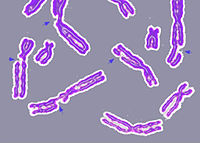
Photo from wikipedia
OBJECTIVE To determine whether analysis of methylated DNA in benign endometrial biopsy (EB) specimens is associated with risk of endometrial cancer (EC). METHODS We identified 23 women with EBs performed… Click to show full abstract
OBJECTIVE To determine whether analysis of methylated DNA in benign endometrial biopsy (EB) specimens is associated with risk of endometrial cancer (EC). METHODS We identified 23 women with EBs performed at Mayo Clinic diagnosed as normal (n = 14) or hyperplasia (n = 9) and who later developed endometrial cancer after a median interval of 1 year. Cases were matched 1:1 with patients with benign EBs who did not develop EC (controls) by histology of benign EB (normal endometrium vs. endometrial hyperplasia without atypia), date of EB, age at EB, and length of post-biopsy follow-up. DNA extracted from formalin-fixed paraffin-embedded tissues underwent pyrosequencing to determine percent methylation of promoter region CpGs at 26 loci in 4 genes (ADCYAP1, HAND2, MME, RASSF1A) previously reported as methylated in EC. RESULTS After pathologic review, 23 matched pairs of cases and controls were identified (14 normal, 9 hyperplasia without atypia per group). Among cases, median time from benign EB to EC was 1 year (range 2 days - 9.2 years). We evaluated 26 CpG sites within 4 genes and found a consistent trend of increasing percentage of methylation from control to case to EC for all CpGs. At the gene-level, mean methylation events of ADCYAP1 and HAND2 in cases were significantly higher than control (p = 0.015 and p = 0.021, respectively). Though the other genes did not reach statistical significance, we observed an increased methylation trend among all genes. Area-under-curve (AUC) calculations (predicting future development of EC in the setting of benign EB) for ADCYAP1 and HAND2 were 0.71 (95% CI 0.55-0.88) and 0.83 (95% CI 0.64-1, respectively). CONCLUSIONS This proof-of-principle study provides evidence that specific methylation patterns in benign EB correlate with future development of EC.
Journal Title: Gynecologic oncology
Year Published: 2020
Link to full text (if available)
Share on Social Media: Sign Up to like & get
recommendations!